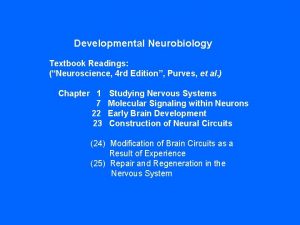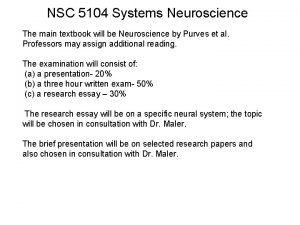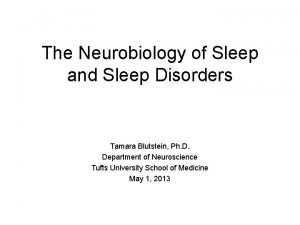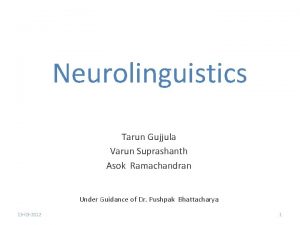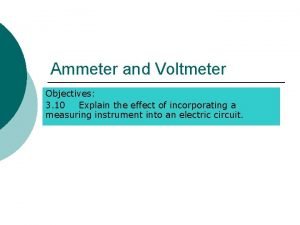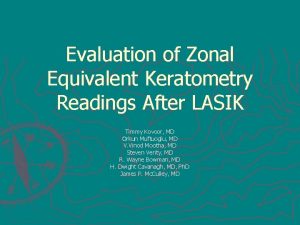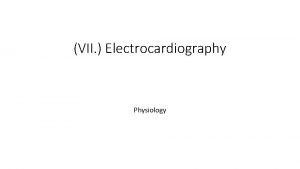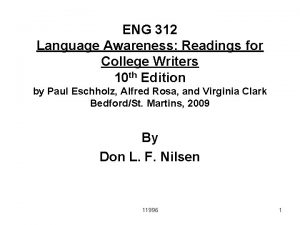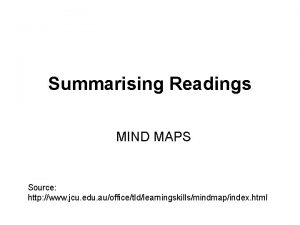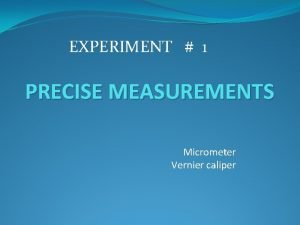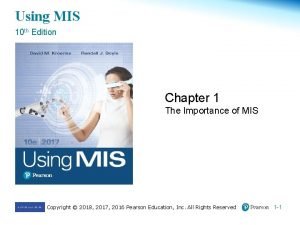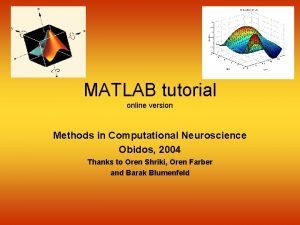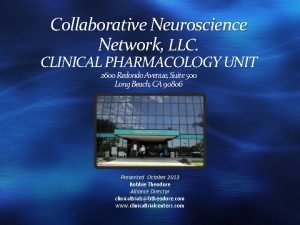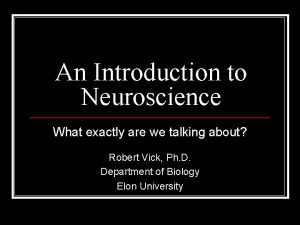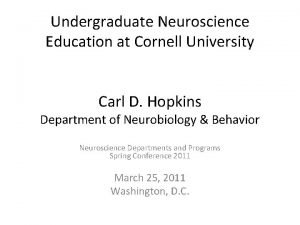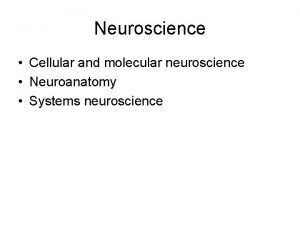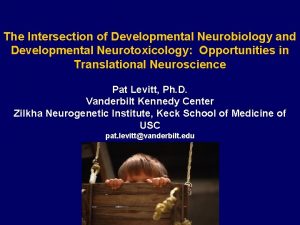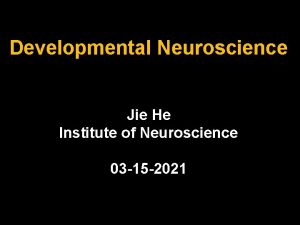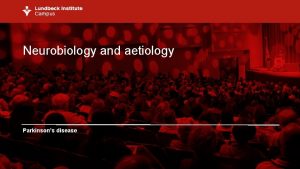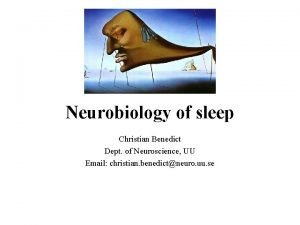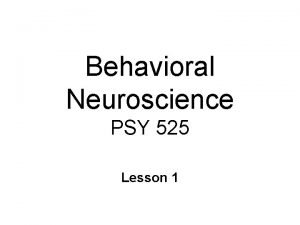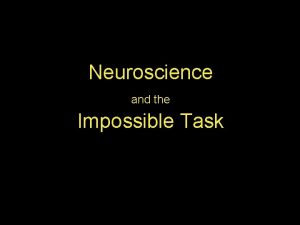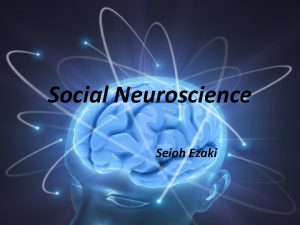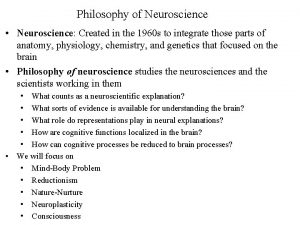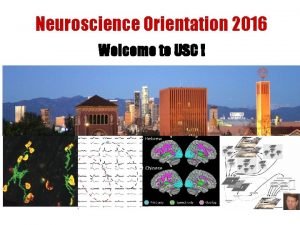Developmental Neurobiology Textbook Readings Neuroscience 4 rd Edition

Developmental Neurobiology Textbook Readings: (“Neuroscience, 4 rd Edition”, Purves, et al. ) Chapter 1 7 22 23 Studying Nervous Systems Molecular Signaling within Neurons Early Brain Development Construction of Neural Circuits (24) Modification of Brain Circuits as a Result of Experience (25) Repair and Regeneration in the Nervous System

Why Study Developmental Neurobiology? Terrific scientific challenge. • To understand the normal construction and operation of the embryonic (and adult) nervous system. • To understand human neuronal diseases, and possible ways to repair and renew the nervous system. • To understand neuronal plasticity, and learning and memory. • To understand the evolutionary diversification of nervous systems.

Emphases of Lectures • Neurodevelopment survey: Highlights of a few key stories. • Cellular and molecular mechanisms. • Synergy of observational and experimental science. • Model organisms. • Impact of Genomics.

Drosophila Optic Lobe (Courtesy of N. Strausfeld, U. Arizona)

Neuronal Circuits Contain Diverse Neurons Which Must Be Wired Exactly In Every Individual Spatiotopy Lo. Lo Me Me VS 1 Stereotopy La La (Borst and Egelhaaf, 1992; Scott, Raabe, Luo, 2002)

Embryonically Regulated Genes are the Most Abundant Genes in the Drosophila Genome (Most of these are Neuronal Genes) (Abeitman, et al. , 2002)

Major Questions 1. Origins. Where do neurons come from? 2. Identity. How does a neuron know what to be? 3. Specificity. How does a neuron make the right connections? 4. Plasticity. How does the nervous system adapt to mistakes or different experiences?

Development proceeds by progressive developmental restrictions (pluripotent, stem cell) (differentiated)

Developmental Restrictions may be: 1) Genetic (programmed by genes) or 2) Epigenetic (determined by environment) (pluripotent, stem cell) (genetic) (environmental) (differentiated)

Recipe for Constructing a Nervous System Selective Assortment Proliferation Morphogenesis (& Segmentation) Axonal Outgrowth & Synapse Formation Specification of Identity Modification by Cell Death & Experience (Plasticity)

Specific Topics Lecture 17 (Mon Oct 29) Embryology of the Nervous System • Germ bands and cell types. • Body axes. • Folding, involutions and morphogenic movements. • Origin, migration and differentiation of neurons. Lecture 18 (Wed Oct 31) Embryonic Neural Induction • Spemann organizer. • Molecular mechanisms of induction (TGF-b). • Intra- and intermolecular signaling. Lecture 19 (Mon Nov 5, Wed Nov 7) Cell Death (Apoptosis) • Cell death and trophic factors (NGF) in developing NS. • Molecular mechanism of apoptosis. Lecture 20 (Mon Nov 12, Wed Nov 14) Patterning Neuronal Connections • Growth Cones. • Axonal guidance cues.

Vertebrate Embryology (Frog) 1. The unfertilized oocyte contains positional information (cytoplasmic determinants) contributed maternally. Some maternal RNAs are not equally distributed. The first informational axis is intrinsic to oocyte! Animal Vegetal (yolk)

2. Fertilization triggers an influx of calcium, that sweeps across the egg. This causes rapid release of cortical granules, forming the fertilization envelope, blocking polyspermy. Animal Sperm entry point Cortical granules Ca+2 Vegetal (yolk)

3. The point of entry of the sperm creates a second positional axis, dorsal (opposite side of entry point) and ventral (entry point). Sperm entry point Cortical Rotation mixes cytoplasmic determinants and creates the dorsal-ventral axis. Animal Vegetal (yolk) Animal Gray Crescent (future blastopore) Ventral Dorsal future Nieuwkoop Center Vegetal (yolk)

Time-Lapse Videos Gray Crescent Formation in Xenopus (Courtesy of Jeffrey Hardin, University of Wisconsin)

Cortical Rotation Leads to Unequal Combinations of Cytosolic Maternal Determinants which Partition into Dividing Embryonic Cells Gray Crescent Nieuwkoop Center

Early Cell Divisions of an Amphibian Embryo Create the Blastula blastomere blastocoel Blastula

Fate Mapping the Blastula: 3 Major Spatial Axes Formed by Gradients of Signaling Molecules (Animal) (Ventral) future Blastopore Site of sperm entry (Dorsal) (Vegetal) 1. Animal/Vegetal (Maternal Determinants) 2. Dorsal/Ventral (Sperm Entry, Cortical Rotation)

Fate Mapping the Blastula: 3 Major Spatial Axes Formed by Gradients of Signaling Molecules; Nieuwkoop Center Induces the Spemann Organizer (Anterior) (Posterior) Spemann Organizer Blastopore Nieuwkoop Center 1. Animal/Vegetal (Maternal Determinants) 2. Dorsal/Ventral (Sperm Entry, Cortical Rotation) 3. Anterior/Posterior (Spemann Organizer)

Fate Map of the Blastula: 3 Principle Germ Bands Created Ectoderm (Skin, Neurons) (Anterior) (Animal) (Posterior) (Ventral) Blastopore Mesoderm (Dorsal) (Notocord, Muscle, Kidney, Bone, Blood) (Vegetal) Endoderm (Lining of Gut, Lungs, Placenta in Mammals)

Gastrulation of the Amphibian Blastula; “tissue origami” by large-scale cellular migrations and morphogenesis

Gastrulation of Xenopus Blastula: 3 -D Microscopic (Confocal) Reconstruction (Ewald, et al. , 2004)

• Endoderm and Mesoderm Involute with Gastrulation • Mesoderm Apposes Overlying (Neuro)Ectoderm, and Induces the Neural Plate Neural plate (Apposition of Different Germbands) Blastopore and yolk plug

Time-Lapse Videos Gastrulation and Neurulation in Xenopus Early Cell Divisions in Zebrafish Embryo (Courtesy of Jeffrey Hardin, University of Wisconsin) (Courtesy of Paul Myers, University of Minnesota)

Neurulation Ant Post Neural Crest D V Closure of the neural tube. Formation of Neural Crest Cells (makes PNS, endocrine cells, pigment cells, connective tissue).

Neurulation: Origin of Floor Plate and Neural Crest

Cephalization and Segmentation of the Neural Tube

Cortical Development: Laminar structure of the cortex is constructed from the inside-out Neurons are born in the ventricular layer and migrate radially along glia to their differentiated adult cortical layer. The earliest born neurons are found closest to the ventricular surface (thymidine pulse-chase labeling of dividing cells). (Rakic, 1974)

Labeling of Single Precusors Reveal Shared Clonal Origins of Radial Glia and Neurons; and Direct Visualization of Radial and Tangential Migrations (Nadarajah, et al. , 2002) (Cepko and Sanes Labs, 1991) (Nector, et al. , 2001)

The amount of yolk determines the symmetry of early cleavages and the shape of the blastula 1. Isolecithal eggs (protochordates, mammals): 2. Mesolecithal eggs (amphibians): 3. Telolecithal eggs (reptiles, birds, fish): (epiboly) (blastodisc)

4. Mammalian eggs have no yolk, so early divisions resemble isolecithal eggs (protochordate-like). However, later stages resemble the blastodisc of telolecithal eggs (reptile/bird/fish-like) a) Blastula flattens into the inner cell mass. b) Endodermal cells form the trophoblast and placental structures.

Key Points of Lecture 17: 1. Three germbands, ectoderm (skin and neurons), mesoderm (muscle, blood and internal organs) and endoderm (lining of the gut). 2. Development proceeds from pleuripotency (stem cells) to the differentiated state (adult neuron). 3. Neuronal induction requires specific contact between groups of cells; embryonic morphogenesis allows this occur. 4. Positional information is created early by asymmetric distribution of molecules. These form axes (Animal/Veg, D/V, Ant/Post) that guide the movement of embryonic cells.

Key Points of Lecture 17 (cont): 5. Key morphological landmarks of embryogensis: a) Fertilization/Cortical Rotation. b) Blastula (hollow ball of cells). c) Gastrulation (inside-out involution of surface cells to the interior, through the blastopore). d) Neurulation (neural tube formation). e) Segmentation/Cephalization. f) Birth of neurons from the ventricular zone. Radial, then tangential migration to final destination.

Embryogenesis (Key Steps): 1. Oocyte possess maternal cytoplasmic determinants. 2. Fertilization triggers calcium influx, and creates dorsal-ventral axis by cortical rotation. 3. Cell divisions, synchronous at first, then asynchronous. 4. Blastula created. (“Hollow” ball of cells) 6. Germ bands (ectoderm, mesoderm, endoderm) created by molecular signals along the Animal/Vegetal axis. 5. Gastulation. (Involution of superficial cells through the blastopore). 6. Anterior-posterior axis created by Spemann organizer.

Embryogenesis (Key Steps) (cont. ): 7. Apposition of future mesoderm with neuroectoderm induces the neural plate. 8. Neurulation. (Lateral neural folds bend over the midline and fuse into the neural tube. ) 9. Neural crest cells derived from leading edge of neural folds, migrate into somites to form the PNS. 10. Segmentation, anterior enlargement (cephalization), cortical development and spinal specification.
- Slides: 35
